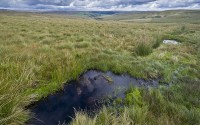Climate Catastrophe – Peatlands to the rescue
- Date
- 14 Apr 2015
- Start time
- 7:30 PM
- Venue
- Tempest Anderson Hall
- Speaker
- Rob Stoneman

Climate catastrophe peatlands to the rescue
A joint lecture with the Yorkshire Wildlife Trust. (Image credit Matthew Roberts)
Rob Stoneman, Chief Executive, Yorkshire Wildlife Trust
On just 3% of the land surface of the world, peatlands are the earths most important terrestrial carbon store. With twice as much carbon as all the worlds forests combined and equivalent to 75% of all atmospheric carbon, this is an exceptionally important part of the global carbon cycle. Yet, peatlands have been so damaged by mans activities, they now act as a source of atmospheric carbon rather than a sink. Reversing that damage offers one of the easiest ways to create a natural carbon capture and storage system.
Rob Stoneman, Chief Executive of Yorkshire Wildlife Trust, is a peatland obsessive with a PhD in palaeoecology studying peat stratigraphy to reconstruct climate change and with over 20 years of work to conserve peatlands in the UK and abroad. Rob chairs the Yorkshire Peat Partnership, that has restored over 20,000 ha of Yorkshires peatlands and is heavily involved in the UK advocacy campaign for peatland restoration the IUCN-UK Peatland Programme. Rob will take the audience on a tour of global peatlands and outline the immense contribution that peatlands can make to avoiding catastrophic climate change.
Due to unforeseen circumstances this is a replacement lecture from the one previously advertised.
Report
Peatlands are a global phenomenon: from Canada, Siberia, Norway, and the UK, to Borneo and Sumatra, Ecuador and Tibet. Formed of mosses and other plants, they grow from the top and die from the bottom, absorbing and trapping enormous amounts of water. They can supply whole cities with water while preventing flooding. They are also a significant carbon sink and act as an atmospheric coolant.
But for decades they have been subject to destruction, to make way for palm oil (the tropics), to burn in power stations (Ireland), or for horticulturists to use as a medium for growing plants. Through human folly, instead of being a carbon store, peat has become a serious carbon source in the atmosphere, causing increased global warming and potentially catastrophic climate change. The acidification of the oceans, extreme weather events like severe flooding or drought, with resulting population displacement and lost food supply, are gradually bringing about policy change and great efforts are being made to restore the peatlands. Their capacity to regrow demonstrates the recuperative power of nature but whether it will be enough to save humanity from itself is not clear.
Carole Smith